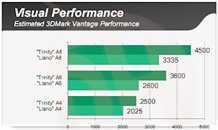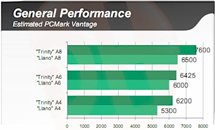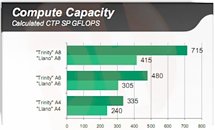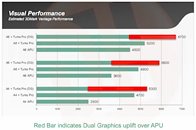Monday, November 21st 2011

AMD Trinity Internal Benchmarks Surface
"Trinity" is the codename of AMD's next-generation performance accelerated processing unit (APU) family. Based on the new socket FM2 package, these chips will take advantage of AMD's next-generation Piledriver processor core architecture and VLIW4 GPU stream processor architecture. Together, Trinity promises increased general, visual, and parallel compute performance. Some of the slides detailing AMD's own performance estimates were put up by DonanimHaber in their recent video bulletin. We screen-grabbed the performance graphs from the low-resolution video, hence the grainy images.
To begin with, AMD is promising noticeable performance improvements over the current "Llano" APU. It spread its benchmarks across three categories: visual performance (using 3DMark Vantage), general performance (using PCMark Vantage), and parallel compute (GPGPU) performance (calculated CTP SP GFLOPs). With 3DMark Vantage, Trinity A8 (quad-core), A6 (triple-core), and A4 (dual-core) APUs are seeing a roughly 32% improvement over their respective Llano-based counterparts; with general performance, the improvement is a candid 13.8% on average; but with GPGPU performance, the improvement is a massive 56.3% on average. This could be attributed to the VLIW4 architecture. Lastly, there are notable CrossFire dual-graphics performance improvements.
Source:
DonanimHaber
To begin with, AMD is promising noticeable performance improvements over the current "Llano" APU. It spread its benchmarks across three categories: visual performance (using 3DMark Vantage), general performance (using PCMark Vantage), and parallel compute (GPGPU) performance (calculated CTP SP GFLOPs). With 3DMark Vantage, Trinity A8 (quad-core), A6 (triple-core), and A4 (dual-core) APUs are seeing a roughly 32% improvement over their respective Llano-based counterparts; with general performance, the improvement is a candid 13.8% on average; but with GPGPU performance, the improvement is a massive 56.3% on average. This could be attributed to the VLIW4 architecture. Lastly, there are notable CrossFire dual-graphics performance improvements.




26 Comments on AMD Trinity Internal Benchmarks Surface
I'm trying to build as cheap yet effective a budget PC for my mate that will play Civ V and Football Manager (the only games he plays). I'm aware Civ V is atrociously optimised. I had been looking at the Llano A8. This looks like a markedly better bet.
He will be using Photoshop CS 5 though which i think is CUDA optimised?
Is nice to see they got the dual GPU working better. But I am curious to see the real world benches. So many of those had dual GPU slower than single.
i hope these arent like the bulldozer ones.
I'm thrilled I bought my A8-3850 instead of waiting like a sucker for a bulldozer-based FM2 part. I would be willing to bet that it will be a turd, apart from the GPU improvements.
And guys, its marketed at a 6550 discrete part.
These are DESIGN TARGETS, not actual perforamnce.
Thanks.
:D
which would be a good choice
amd trinity + 6750
or
i3 2100+6750 ?
That doesn't sound right to me... 1 module, 2 integer cores. 2 modules, 4 integer cores. 3 integer cores? weird.
This sounds fake to me.
Problems:
-Huge price
-Too much heat to dissipate
-Huge die
-Memory bandwidth couldn't feed 800sp
mo problems
Bad PR because artificially fusing one core in one module is going to piss off the people who will buy it thinking they can unlock, because it won't be a simple unlock if its bad silicon, that would be a loss of profit to AMD. APUs make money for AMD. It's not the same situation as the Phenom x2 and x3.
Fake.